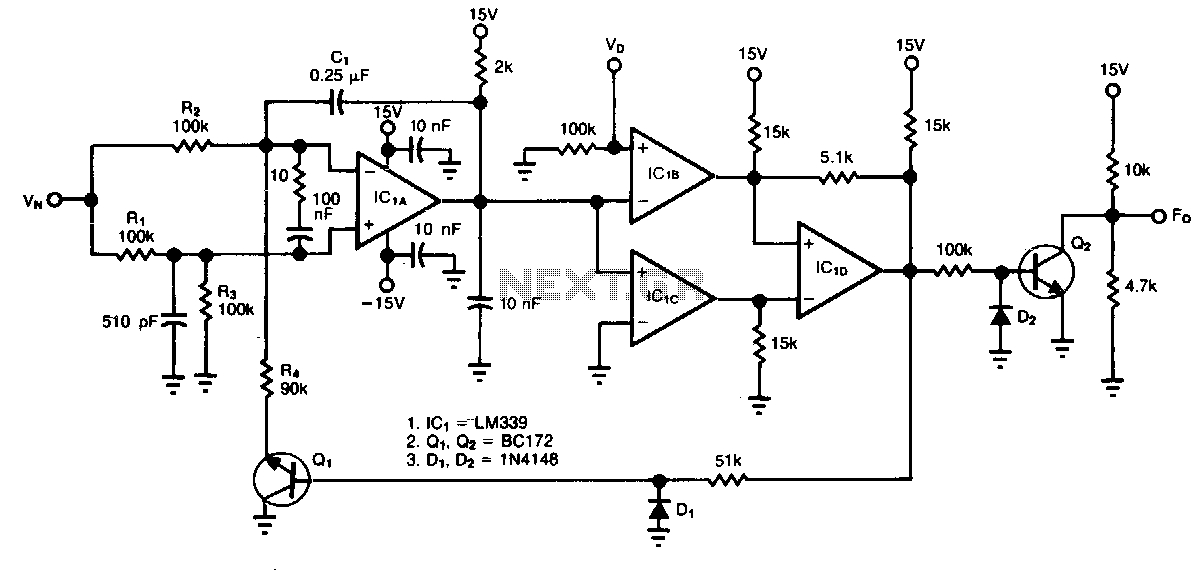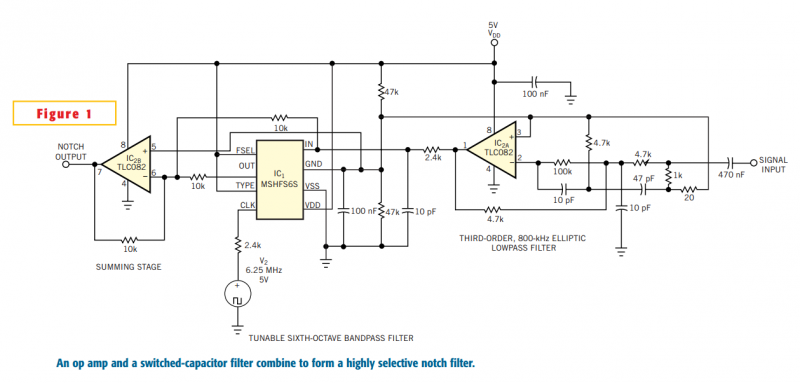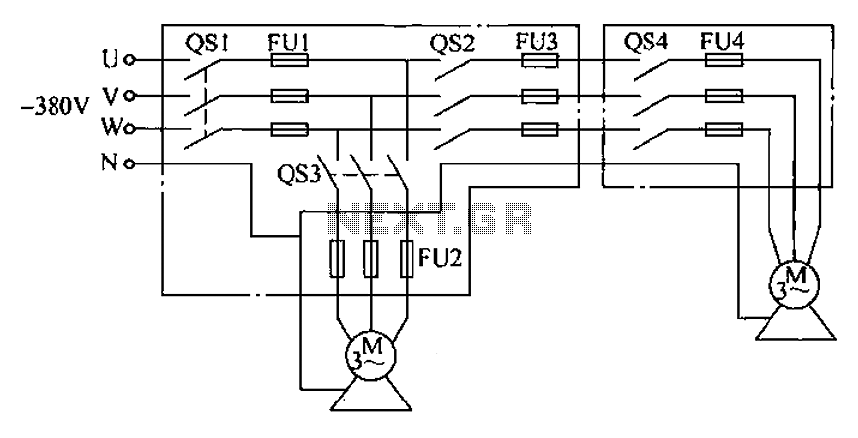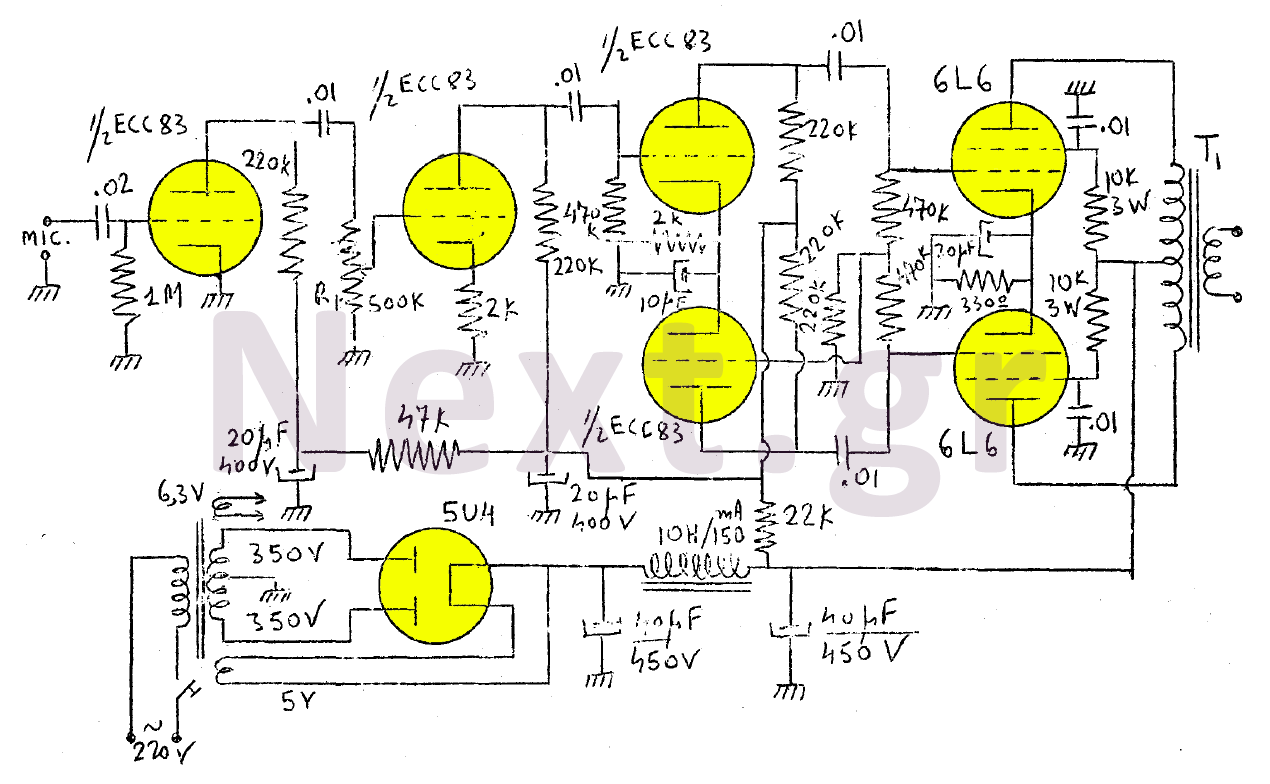
low frequency oscillator
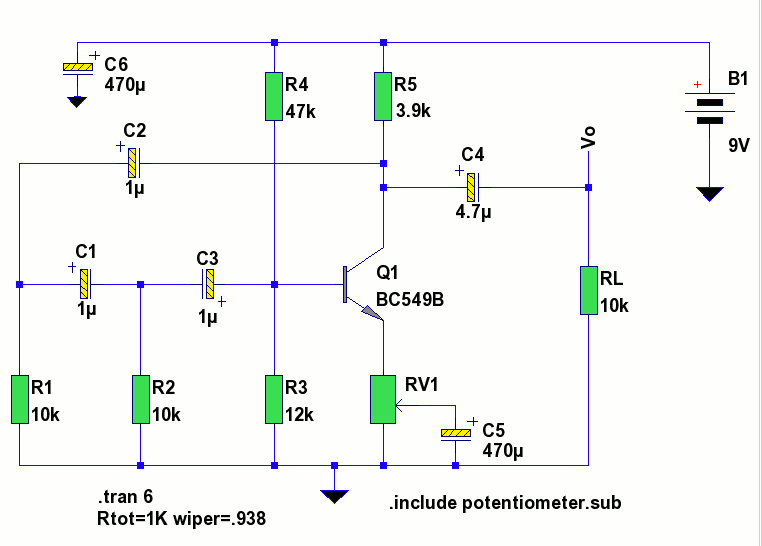
The circuit is a standard RC phase shift oscillator that utilizes a single bipolar transistor as the active component. When power is supplied, regenerative feedback is applied through capacitor C2 from the collector to the base of the transistor. The timing components, R1, R2, C1, and C3, determine the oscillation frequency. During operation, the preset resistor RV1 is adjusted to initiate oscillation. With the specified component values, full amplitude oscillation occurs in approximately 4.8 seconds. This oscillator has been designed and simulated using LTSpice IV. To observe the output waveform, the "probe" cursor can be placed on the output wire "Vo." To calculate the frequency, the user should position the mouse on the graph where oscillations have reached full amplitude and draw a rectangle that encompasses the maximum and minimum amplitude. A zoomed portion of the output waveform is available, beginning around 5.6 seconds into the simulation. Cursors can be added to the output waveform by left-clicking on "V(vo)." A single cursor can then be moved with the mouse or keyboard arrows. By right-clicking on the V(vo) waveform, the attached cursor menu can be accessed to change to "1st & 2nd," allowing for two controllable cursors. It is important to ensure both cursors intersect the zero-volt horizontal line to measure one output cycle. A sub-window will display the measurement values, indicating that for this oscillator, the time for one cycle is 127.2 ms and the frequency is slightly below 8 Hz.
The RC phase shift oscillator is a fundamental circuit widely used in various applications such as signal generation, audio frequency generation, and waveform synthesis. The configuration consists of a single bipolar junction transistor (BJT) that serves as the active amplification element, while the passive components (resistors and capacitors) form the phase shift network necessary for oscillation.
In this oscillator, the phase shift is achieved through a combination of resistors (R1 and R2) and capacitors (C1 and C3), which are arranged to provide a total phase shift of 180 degrees at the desired frequency. The feedback capacitor C2, connected from the collector to the base, reinforces the oscillation by providing the necessary positive feedback.
The oscillation frequency is primarily determined by the values of the resistors and capacitors in the timing network. The relationship between these components can be derived from the standard formula for the frequency of an RC phase shift oscillator, which typically involves the time constant of the RC network.
In practical applications, adjustments to the preset resistor RV1 allow for fine-tuning of the oscillation start point, ensuring that the circuit can reliably commence oscillation under varying conditions. The simulation results obtained from LTSpice IV provide a visual representation of the output waveform, which can be analyzed for characteristics such as amplitude stability and frequency accuracy.
The ability to measure the oscillation frequency accurately is crucial for applications requiring precise timing and frequency control. The method of using cursors in the simulation software to measure the time period of the waveform is a standard practice that enhances the understanding of the oscillator's performance. The resultant frequency of just under 8 Hz indicates that this circuit is suitable for low-frequency applications, where stability and reliability are paramount.
Overall, the design and simulation of the RC phase shift oscillator exemplify essential principles in electronic circuit design, showcasing the interplay between active and passive components in generating oscillatory signals.The circuit is a standard RC phase shift oscillator using a single bipolar transistor as the active element. When power is applied regenerative feedback is applied via C2 from collector to base of the transistor.
The timing components, R1, R2, C1 and C3 dictate the oscillation frequency. In use preset RV1 is adjusted so that oscillation just begins . With values shown full amplitude oscillation takes about 4. 8 seconds (see diagram below). This oscillator is designed and simulated on LTSpice IV. Once simulated click the "probe" cursor on the output wire "Vo", the above waveform is produced. To calculate the frequency, place your mouse on the graph where oscillations have reached full amplitude and draw a rectangle, ensuring maximum and minimum amplitude is enclosed within the rectangle. The diagram below shows such a zoomed portion of the output waveform, starting around 5. 6 seconds into the simulation. To add cursors left click on the name of the output waveform, this is called "V(vo)". A single cursor is added to the graph which can be moved with the mouse or keyboard arrows. Now right click the mouse on the Vvo waveform. In the window that appears click on the attached cursor menu and change to "1st & 2nd". Now two cursors will be visible and controllable. Make sure both cursors pass through the zero volt horizontal meridian and measure one output cycle. A sub window allows you to read the value as shown above, for this oscillator the time for one cycle is 127.
2ms and frequency a little under 8Hz. 🔗 External reference
The RC phase shift oscillator is a fundamental circuit widely used in various applications such as signal generation, audio frequency generation, and waveform synthesis. The configuration consists of a single bipolar junction transistor (BJT) that serves as the active amplification element, while the passive components (resistors and capacitors) form the phase shift network necessary for oscillation.
In this oscillator, the phase shift is achieved through a combination of resistors (R1 and R2) and capacitors (C1 and C3), which are arranged to provide a total phase shift of 180 degrees at the desired frequency. The feedback capacitor C2, connected from the collector to the base, reinforces the oscillation by providing the necessary positive feedback.
The oscillation frequency is primarily determined by the values of the resistors and capacitors in the timing network. The relationship between these components can be derived from the standard formula for the frequency of an RC phase shift oscillator, which typically involves the time constant of the RC network.
In practical applications, adjustments to the preset resistor RV1 allow for fine-tuning of the oscillation start point, ensuring that the circuit can reliably commence oscillation under varying conditions. The simulation results obtained from LTSpice IV provide a visual representation of the output waveform, which can be analyzed for characteristics such as amplitude stability and frequency accuracy.
The ability to measure the oscillation frequency accurately is crucial for applications requiring precise timing and frequency control. The method of using cursors in the simulation software to measure the time period of the waveform is a standard practice that enhances the understanding of the oscillator's performance. The resultant frequency of just under 8 Hz indicates that this circuit is suitable for low-frequency applications, where stability and reliability are paramount.
Overall, the design and simulation of the RC phase shift oscillator exemplify essential principles in electronic circuit design, showcasing the interplay between active and passive components in generating oscillatory signals.The circuit is a standard RC phase shift oscillator using a single bipolar transistor as the active element. When power is applied regenerative feedback is applied via C2 from collector to base of the transistor.
The timing components, R1, R2, C1 and C3 dictate the oscillation frequency. In use preset RV1 is adjusted so that oscillation just begins . With values shown full amplitude oscillation takes about 4. 8 seconds (see diagram below). This oscillator is designed and simulated on LTSpice IV. Once simulated click the "probe" cursor on the output wire "Vo", the above waveform is produced. To calculate the frequency, place your mouse on the graph where oscillations have reached full amplitude and draw a rectangle, ensuring maximum and minimum amplitude is enclosed within the rectangle. The diagram below shows such a zoomed portion of the output waveform, starting around 5. 6 seconds into the simulation. To add cursors left click on the name of the output waveform, this is called "V(vo)". A single cursor is added to the graph which can be moved with the mouse or keyboard arrows. Now right click the mouse on the Vvo waveform. In the window that appears click on the attached cursor menu and change to "1st & 2nd". Now two cursors will be visible and controllable. Make sure both cursors pass through the zero volt horizontal meridian and measure one output cycle. A sub window allows you to read the value as shown above, for this oscillator the time for one cycle is 127.
2ms and frequency a little under 8Hz. 🔗 External reference
